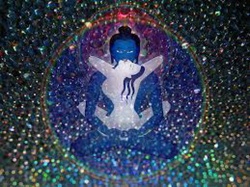Āyatana
- See also:Ayatana
1. 'spheres', is a name for the four immaterial absorptions; s. jhāna (5-8).
2. The 12 'bases' or 'sources' on which depend the mental processes, consist of five physical sense-organs and consciousness, being the six personal (ajjhattika) bases; and the six objects, the so-called external (bāhira) bases - namely:
- eye, or visual organ visible object
- ear, or auditory organ sound, or audible object
- nose, or olfactory organ odour, or olfactive object
- tongue, or gustatory organ taste, or gustative object
- body, or tactile organ body-impression, or tactile object
- mind-base, or consciousness mind-object (manāyatana) (dhammāyatana)
"By the visual organ (cakkhāyatana) is meant the sensitive part of the eye (cakkhu-pasāda) built up of the four elements ... responding to sense-stimuli" (sa-ppatigha).... (Vibh. II). Similar is the explanation of the four remaining physical sense-organs.
Mind-base (manāyatana) is a collective term for all consciousness whatever, and should therefore not be confounded with the mind-element (mano-dhātu; s. dhātu II, 16), which latter performs only the functions of adverting (āvajjana) to the sense-object, and of receiving (sampaticchana) the sense-object. On the functions of the mind, s. viññāna-kicca.
The visible object (rūpāyatana) is described in Vibh. II as "that phenomenon which is built up of the four physical elements and appears as color, etc." What is' seen by-visual perception, i.e. by eye-consciousness (cakkhu-viññāna) are colors and differences of light, but not three dimensional bodily things.
'Mind-object-base' (dhammāyatana) is identical with 'mind-object-element' (dhamma-dhātu; s. dhātu II) and dhammārammana (s. ārammana). It may be physical or mental, past, present or future, real or imaginary.
The 5 physical sense-organs are also called faculties (indriya), and of these faculties it is said in M. 43: "Each of the five faculties owns a different sphere, and none of them partakes of the sphere of another one; ... they have mind as their support... are conditioned by vitality, ... but vitality again is conditioned by heat, heat again by vitality, just as the light and flame of a burning lamp are mutually conditioned."
The 12 bases are fully discussed in Vis.M. XV. In Yam III (s Guide, p 98f) the 12 terms are subjected to a logical investigation The six personal bases form the 5th link of dependent origination (paticca-samuppāda 5).
